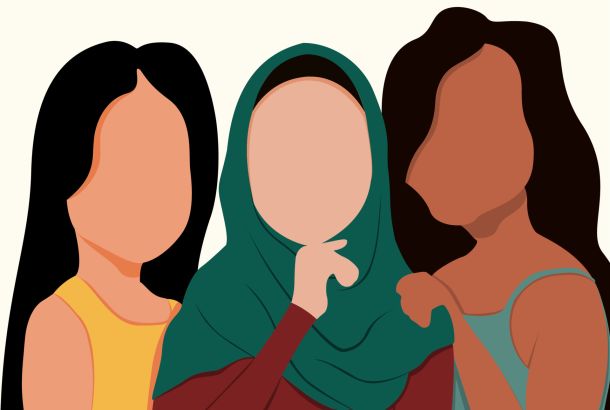Yes, there’s comfort in conformity – but it’s less fun: The internet is killing individuality

We know that the internet has changed the way we present ourselves. Social media has birthed the rapidly changing micro-trend; with constant new style fixations dominating our feeds, soon to be sold across fast-fashion stores in the form of cheap, 100% polyester duplicates. Next month, you’ll see the same clothing flooding second-hand sites like Vinted, suddenly unwearable.
This decade can’t be characterised by specific ways of dressing as it has been in the past: the fashion of 2020 is already viewed as extremely dated due to the increasingly rapid online trend cycles. Our personal tastes are being governed by fast-moving algorithms which drive overconsumption and kill our individuality.
Most social media users would be able to identify how our online feeds mould our self-expression, and it’s not just clothing. After scrolling through hundreds variations of the same comment under a post and thousands of identical Hinge profile prompts about “Sunday roasts and a walk”, you’ll suddenly feel like you’re living in a world of clones. It’s not just on your phone – the trend cycles filling our feeds also spill out onto the streets.
How can you form your own identity if an internet algorithm decides it for you? An overdependent relationship with social media is playing a role in making us all less individual.
The idea of ‘subcultures’ seems to be far less relevant in the digital age, which is perhaps indicative of the new ways in which we form our identities. Cambridge Dictionary defines a subculture as ‘the way of life, customs and ideals’ of a group that is ‘different from the rest of society’. They are often associated with world-changing youth movements, but from hippie to punk, social media seems to push watered-down versions of these groups, focusing largely on visual appearance.
The political mindsets or lifestyle choices of subcultures are often neglected, the videos under subculture hashtags being more concerned with where you bought the decorations in your room (mostly sourced from Shein or Amazon). It’s also noticeable that where subculture groups would formerly exist separately, many of them now roll into one online, the concept of “alternative”, or often abbreviated to “alt”, being an umbrella term for anybody who appears slightly less mainstream.
When researching the concept of subculture, Google’s suggested search auto-filled the question, “What subculture am I?”. There followed many quizzes, designed to take everything from your favourite colour to your hair length and assign you a subculture. Undeniably, it’s a bit of fun to imagine yourself in a new style, and the fluidity of identity in modern life means the way that we present ourselves doesn’t have to be rigid. It’s understandable that we’re all searching for community in a constantly unstable world. However, we’re increasingly finding our sense of self amongst the narrow, infinitely changing and often meaningless labels of online culture.
Perhaps in the place of subculture, we have the rise of the ‘aesthetic’, a new way to categorise your fashion choices, music taste and lifestyle. The aesthetic tends to be more superficial in its capitalist element, often based on the acquisition of objects, normally the same few albums, outfits, or accessories.
These online identities require certain social signifiers that are pushed by influencers: Do you like the outdoors and rural life? You’re “cottagecore”, buy the appropriate clothing from the link in my bio.
Most of these “aesthetics” are geared towards women, from the “clean girl” to “sad girl”, the list goes on. Predictably, many enforce a multitude of new idealising and unhealthy standards for young women and girls, capitalising on wellness or even glamourising poor mental health.
Moreover, to fit into the ‘aesthetic’, many of the clothes you’ll be encouraged to buy will be sourced from fast fashion brands, feeding into our problem with overconsumption. The tropes and fashion attached to these ‘aesthetics’ pretend to signal who we are, but are only the products of short-lived trends. For the most part, the algorithm recycles the same few looks and songs, promoted by the same impossibly beautiful people until we want something new.
In the formative years of life, the internet doesn’t provide us with the reflection of reality that we need. If we’re getting all our inspiration from identical influencers and always falling behind a new trend, we’ll never find personal satisfaction. The concept of ‘cool’ is becoming ever more codified by the internet, and it’s impossible to retain a sense of individual identity if online content dictates our lives.
The consumption of short-form video content facilitates these fast-moving trend cycles. We crave instant gratification from these clips – with options to put TikToks on double speed or to scroll as soon as we become bored, we develop a need for constant stimulation. In Forbes, Dr. Julie Albright discusses how this content releases dopamine to our brains. She sees the need to scroll for a potentially satisfying video as reflecting the ‘random reinforcement’ of a gambling addiction.
These mental developments impact the way we view the world, and ourselves. Trends function entirely differently when they can reach anyone, anywhere, and anytime through social media. Social media has a better grasp over us than television advertisements or print media due to its uniquely tailored algorithm.
Such platforms are largely responsible for the repetitive circulation of the same jokes, phrases and trends. When we over-engage with social media it is only natural to adopt the characteristics, mannerisms, and ways of being of the people that we watch. Just as we can pick up new accents from prolonged exposure, the internet can shape the way we speak and behave.
Social media can become an echo chamber, algorithms streamlining us towards content that reflects what we believe are our own desires and opinions. What we consume in large quantities in our daily lives inevitably influences who we are, going so far as to put us in boxes and limit true self-expression.
Yes, there’s comfort in conformity – but it’s less fun. Embracing our differences and individuality is what makes the world interesting and is the driving force of creativity. Whilst the internet’s ubiquitous presence increases the pressure on young people to correspond with the online ideal, we must learn to take a step back. Social media forces us to be self-obsessed, but it’s not helpful to anyone. Everyone could do with a little less time online, to help our culture of consumption and develop our sense of self. You don’t need to renew yourself every few months and you have time to figure it out.







